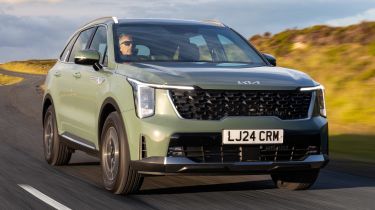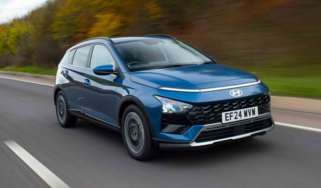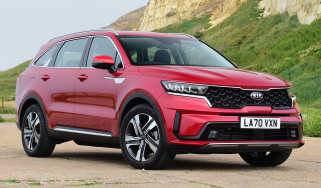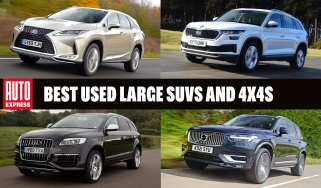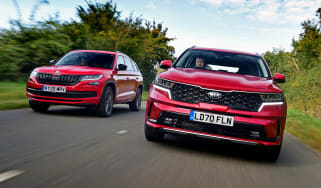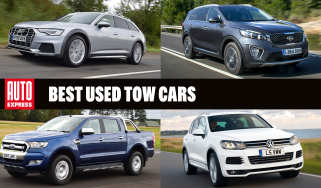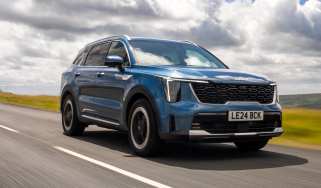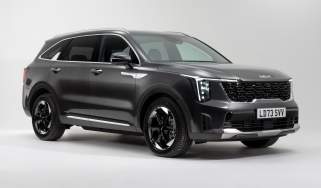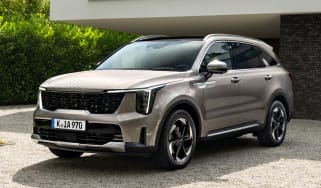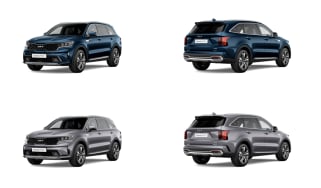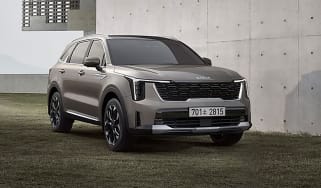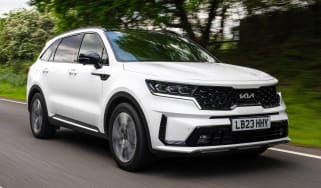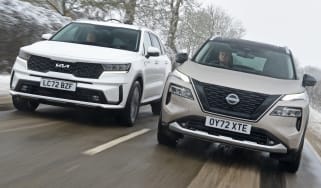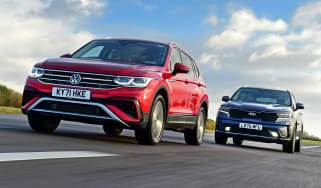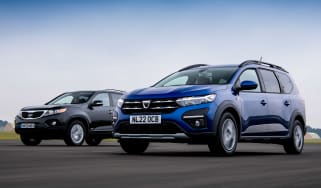Kia Sorento review
The Kia Sorento is a top-class family SUV with plenty of kit and space, although it's expensive to buy

Seven-seat SUVs might seem like an alternative to people carriers and for the most part they are - but the Kia Sorento looks able to cater for a wider range of buyers with its standard-fit four-wheel drive and range of plug-in hybrid, hybrid and diesel powertrains. There’s no all-electric option but that gap is filled by the similarly-sized Kia EV9.
Over the years, the Kia Sorento has evolved from being a large, practical and cheap family SUV into a large, practical and classy one. The price has shifted in line with the upturn in quality, design and technology, but you do get a lot of equipment and technology included as standard. The difference now is that the Sorento is up against some first-rate rivals in the seven-seat SUV market.
About the Kia Sorento
Car buyers with big families naturally gravitate towards big vehicles with plenty of space. In today’s market, with the fortunes of the purpose-built MPV on the wane, that largely limits those with a lot of children or luggage to a van with windows and seats, or a large SUV.
The Kia Sorento has been a force in the large-SUV market since the first-generation model launched in 2002. Today we’re on the Mk4 Sorento, which has undergone its mid-life facelift, and it’s a model that clearly shows how Kia has matured as a car brand in the intervening years. The original Sorento was a budget option, a large seven-seat SUV for the price of a mid-size five-seater from one of the leading mainstream brands at the time.
Used - available now

2019 KIA
Sorento
65,256 milesManualDiesel2.2L
Cash £16,150
2022 KIA
Sorento
23,737 milesAutomaticPetrol1.6L
Cash £28,800
2019 KIA
Sorento
37,516 milesAutomaticDiesel2.2L
Cash £22,796
2013 KIA
Sorento
84,450 milesManualDiesel2.2L
Cash £6,795Today it's probably fair to say that Kia is in the leading pack of those mainstream brands, offering models that easily stand comparison with products from the likes of Ford, Volkswagen, Renault and Peugeot. Indeed, in terms of style, build quality and technology, Kia has designs on surpassing these rivals and pushing further upmarket still.
The fourth-generation Kia Sorento was revealed to the public in early 2020 and went on sale in the UK later that year. Then it received a mid-life refresh in 2024. It’s a seven-seat SUV and it sits at the top of Kia's combustion-powered SUV range. Below the Sorento are the mid-size Sportage, more compact Niro and even smaller Stonic, but Kia also offers the XCeed crossover as well as the Soul EV electric SUV.
Kia offers 2, 3 and 4 trim levels for the Sorento. Standard kit on the base ‘2’ models is impressive with heated front seats, dual automatic air-conditioning, wireless Apple CarPlay and Android Auto, six USB-C charge ports and a reversing camera. Higher-specification Sorentos come with a few more premium touches like a panoramic sunroof, black leather upholstery, a head-up display and even a digital rear view mirror.
Under the bonnet you have a three options: the standard 2.2-litre CRDi diesel with an eight-speed DCT dual-clutch automatic gearbox, a full-hybrid with an electrically assisted 1.6-litre T-GDi petrol engine and a six-speed auto gearbox, or a plug-in hybrid that uses the same petrol engine and gearbox but increases the battery size to 13.8kWh, enabling up to 35 miles of electric-only travel. All models are four-wheel drive.
Kia Sorento Alternatives
In terms of direct rivals, the Sorento is in the mix with a clutch of desirable full-size seven-seat SUV options. The Skoda Kodiaq and SEAT Tarraco from the Volkswagen Group share technology, while the Peugeot 5008 is another worthy candidate. Land Rover has the Discovery, although the Sorento sits nearer to the smaller Discovery Sport in price, starting at around £42,000. The Sorento's sister model, the Hyundai Santa Fe, is a similarly practical seven-seater, as is the Nissan X-Trail that we’ve previously put head-to-head against the Sorento in hybrid form.
Engines, performance and drive
It might be a big all-wheel drive SUV, but the Kia Sorento offers polished road manners and a surprising turn of pace. It rides on fully independent suspension and has a 35mm-longer wheelbase than the old model, which is intended to improve comfort levels. The ride feels cosseting enough, especially for a car in this class. There’s spongy damping to take the edge off, but you still get the odd jarring impact on poorly surfaced B-roads. Large speed bumps highlight just how softly-sprung the front of the Sorento is - as do tight turns.
Despite having a fairly relaxed suspension set up, the Sorento offers better body control than you expect through sweeping corners as well as a resistance to the floating feeling over undulations in the carriageway. For a seven-seat SUV, the Sorento largely feels composed and capable, the self-levelling rear suspension on the higher-spec cars helping maintain this when there’s a lot of weight on board. The steering does feel a little remote, with no feedback keeping you in touch with the front wheels, but the overall driving experience is well up to scratch for this sector.
When we pitted the Sorento Hybrid head-to-head against the Nissan X-Trail, the Nissan felt lighter and more lively. The X-Trail is shorter and turns more tightly than its rival too, so it’s easier to drive in tight spots than the Sorento. The Kia also had a firmer ride than the Nissan, plus its huge door mirrors almost certainly contribute to all of the wind noise we noticed at high speeds, but they do give the driver a great view of what’s going on behind the car.
At least every Sorento has four-wheel drive, and for this generation Kia introduced its Terrain Mode function, which is essentially a set of driving modes that alter various parameters of the car’s set-up according to the terrain under the tyres. Land Rover’s Terrain Response system was clearly the inspiration.
The driver can select Mud, Snow and Sand modes, as well as introduce bespoke settings for the gearbox, ESC stability control and 4x4 system that are optimised for the different conditions. There are no locking differentials or low-range gearboxes, so don’t think of the Sorento as an extreme off-roader, but it should have enough muscle and grip to get you out of a muddy car park or up a snowy mountain road to a ski resort, should the need arise.
0-62mph acceleration and top speed
The Sorento engine line-up is strong with a selection of a diesel, plug-in hybrid and full-hybrid. The diesel comes in the shape of Kia’s 2.2-litre CRDi unit paired with an eight-speed dual-clutch gearbox. It’s the least powerful option in the range, producing 190bhp and 440Nm of torque in total. The engine has an aluminium block, making it 19.5kg lighter than the cast-iron block version that was the mainstay of the Mk3 Sorento range. The 0-62mph sprint takes 9.7 seconds, which is hardly slow for a large SUV, and it manages the Sorento’s highest top speed of 124mph.
The Sorento Hybrid has a 1.6-litre T-GDi turbocharged petrol engine, six-speed automatic gearbox and 1.49kWh battery pack feeding a 59bhp electric motor for a combined output of 212bhp and 367Nm of torque. Acceleration matches the diesel with 0-62mph done in exactly 9.7 seconds before topping out at 113mph.
Finally, the plug-in hybrid Sorento PHEV has the same engine and gearbox combo as the self-charging hybrid, but the battery is 13.8kWh and the electric motor offers a 90bhp boost. That makes for an output of 248bhp combined with a healthy 367Nm of torque. The 0-62mph dash takes 8.8 seconds and the top speed is 113mph.
The self-charging hybrid powertrain seems like the one to choose for buyers who aren’t bothered about accessing the substantial company car tax breaks that come with the plug-in hybrid, and who also don’t need the diesel’s muscle. Its powertrain is pretty refined unless you push it hard - where it can sound a little gruff, yet it’s also punchy with the electrical assistance at low speeds. The PHEV is all but silent in EV mode, but can be slow to respond when you put your foot down as the system works out which power source to use. There’s also a tendency for the petrol engine to cut in and out when you’re at a standstill.
The diesel would have been the default choice for a big SUV a few years ago and its strength will still make it the preferred option for those who plan on making their Sorento work hard on towing or light off-roading duties. It’s a smooth unit that eases the power on in a gentle fashion, and it only gets loud at the top end of the rev range. The eight-speed gearbox works very well, its changes all but imperceptible most of the time, making the diesel Sorento a convincing package. We recommend leaving the Sorento in the ‘Standard’ or ‘Smart’ drive modes as the ‘Sport’ mode stays one or two gears lower - affecting fuel efficiency and not adding too much to the performance. We’d also suggest ignoring the manual gearshift paddles behind the wheel as they’re pretty slow to respond.
MPG, CO2 & running costs
The Kia Sorento isn’t the budget option in the large SUV class that it once was, but its hi-tech powertrains should help to keep running costs in check. Unsurprisingly, the amount you’ll spend on running your Sorento will depend greatly on your choice of powertrain, diesel, hybrid or plug-in hybrid.
The diesel and the hybrid are pretty close in terms of their raw numbers. According to Kia, the diesel Sorento in basic ‘2’ trim can return up to 43.5mpg and emits 170g/km of CO2, and during a mixture of motorway and country roads our fuel economy figure was pretty close to Kia’s when we tested this version.
We found it a little more difficult to match the official economy figures in the self-charging hybrid Sorento. It has an official WLTP-rated fuel economy figure of 42.2mpg and CO2 emissions of 153g/km, and when we pitted the electrified Sorento head-to-head against a Nissan X-Trail it achieved 38.7mpg, with the Nissan trumping it with 42.8mpg. The diesel is also around £1,900 cheaper than the non-plug-in hybrid model, which is another factor to consider.
However, the plug-in hybrid Sorento PHEV is the star of the show for on-paper economy, with an official rating of 176.6mpg and 37g/km CO2. There is, of course, always the plug-in hybrid caveat that achieving such returns in the real world will be very difficult unless you charge the car religiously and stick to short trips that lean mostly on the 35-mile electric-only range.
Kia’s plug-in hybrid costs over £4,000 more than the self-charging hybrid version in the same specification. The big plus comes for company car drivers, who will benefit from significant savings in BiK company car tax thanks to the 37g/km CO2 emissions of the Sorento PHEV.
Electric range, battery and charging
The electric range of the Kia Sorento PHEV is 35 miles officially, but you could get closer to 40 miles in urban environments while our test route of mixed driving saw the battery exhausted after 27 miles. To charge the 13.8kWh battery in the car, you’ll be looking at five hours from a domestic three-pin plug, or three hours and 25 minutes from a home wallbox. Charging cable for both come as standard with the plug-in model.
Insurance groups
The hybrid Sorento in ‘2’ trim sits in insurance group 25 (out of 50), rising to group 31 for the diesel in ‘3’ trim. The range-topping plug-in hybrid version in ‘4’ trim is in group 35. The Skoda Kodiaq is going to be a cheaper car to insure, sitting in groups 12 to 30 depending on engine and trim, meanwhile the Nissan X-Trail attracts ratings between groups 22 and 31.
Depreciation
Predicted residual values for the Sorento have the car retaining 51 per cent for the diesel models, 57 per cent for the hybrid and 55 per cent for the plug-in hybrid - all after three years and 36,000 miles. It’s worth noting that these figures are based on the pre-facelifted model.
For reference, the Hyundai Santa Fe has very similar predicted values to the Kia (56 per cent on average), but Land Rover’s Discovery Sport averages 62 per cent.
Interior, design and technology
The Sorento is your typical bluff-fronted family SUV in shape, but Kia’s intention to continue its push upmarket is evidenced in some assured design touches. The mid-life refresh that came in 2024 provided a similar face to the rest of Kia’s line up - influenced by the all-electric range of EV-branded Kias, especially the EV9.
At the front the facelifted car received a new take on Kia’s ‘Tiger Nose’ grille, with fresh ‘star map’ headlights to help it look larger and more aggressive on the road. The rear got a more subtle update with new signatures for the rear lights and a reshaped bumper. Overall, the Sorento does little that’s special or unusual in the large-SUV segment, but it’s a handsome car nonetheless.
Inside, the positive impression continues, particularly if you haven’t kept track of Kia’s swift improvement in the perceived quality stakes in recent years. The quality of the plastics is a let-down in places, particularly the textured finish applied to the passenger side of the dash and the doors, and the piano-black finishes on certain surfaces may also be susceptible to scratches, but generally the cabin looks good. The design is also more adventurous than rivals like the X-Trail’s.There isn’t the classy minimalist approach that some brands strive for – although more touch sensitive buttons arrived with the facelift - replacing physical controls for major controls like the climate and radio. Don’t think they’re fiddly to use however, because it’s the same bank of buttons that the EV6 and EV9 use and we think they’re simple enough to operate while driving. There are no covers for the ample cubbies in the centre console – but the Sorento is more user friendly as a result.
When the pre-facelift Sorento bowed out there was just one trim level called Edition. Thankfully, the facelift brought back a selection of ‘2’, ‘3’ and ‘4’ specifications with a varied amount of kit between them. Standard equipment is pretty good in the Sorento with automatic headlights, roof rails, rain-sensing front wipers, dual automatic air-conditioning, heated front seats and steering wheel, six USB-C ports, a 12.3-inch central touchscreen with in-built sat-nav, wireless Apple CarPlay and Android Auto and a reversing camera.
The ‘3’ builds on this with 19-inch alloy wheels (instead of the 2’s 17-inch rims), tinted windows, black leather upholstery, a 12.3-inch driver’s display, a Bose premium sound system, a wireless smartphone charger, ambient lighting, a 360-degree camera and rear self-levelling suspension.
Sitting at the top of the range, the ‘4’ includes 19-inch alloy wheels for hybrid and PHEV (20-inch on diesel), an electric panoramic sunroof, ventilated front seats, an electronic rear-view mirror and a customisable head-up display. The facelifted car added a fingerprint recognition system that allowed the driver to start the engine and can also be operated by a PIN code.
Sat-nav, stereo and infotainment
Kia's latest infotainment technology is slick and easy to use, aided by the easy touchscreen controls in the Sorento. The menus are logical, with the main functions easily accessible through a single menu page. Loading times are reasonable, but confirming a route on the navigation system includes what seem like a couple of redundant button presses.
Instead of the old 10.25-inch screen in the pre-facelift model, the facelifted Sorento gets a 12.3-inch touchscreen which works well. With the black background it’s a little hard to read in glaring sun, but it’s a simple enough layout.
The digital driver’s display presents its information clearly, and it’s through here that you can adjust the driver-assist systems, and delve into the trip computer functions in greater detail.
The Sorento Edition also comes with UVO Connect telematic services that add live traffic information, weather and parking information into the mix. Using the phone app, it lets you send routes to the car in advance of your journey, too. The infotainment system can pair two phones at the same time via Bluetooth, so one could be playing music while the other makes a call. Of course, Apple CarPlay and Android Auto smartphone connectivity are standard too.
There are loads of USB chargers with two in the front, three more in the middle row and a further pair in the boot/third-row area – there’s basically one for each occupant, while a wireless charging mat in the front means someone can even bring a second device with them.
Practicality, comfort & boot space
Cabin space is the Kia Sorento’s greatest strength, it makes good use of its sizable exterior dimensions, translating them into a spacious and user-friendly cabin. There’s generous space for four adults, and the two extra seats in the back are more comfortable than you’ll find on many rival seven-seaters.
Storage space isn’t in short supply, either, because there’s plenty of room in the centre console with cup-holders and a large area for charging devices. Speaking of charging, there are loads of USB sockets all over the cabin, with one for every occupant to keep their device topped up.
In the middle row, occupants get individual cup-holders in the door plus a second cubby lower down that could hold a drinks bottle. The centre armrest has more cup-holders, too, but because the middle seat is a little narrow this is probably best used as an armrest. The hybrid models position their batteries under the cabin floor, so there’s minimal boot-space penalty on these Sorentos compared with the diesel. The middle row also slides forward to allow for easy access to the third row.
Dimensions and size
This is a big vehicle, but it’s not up there with the largest seven-seat SUVs on the UK market. The Kia Sorento is 1,700mm tall, 4,815mm long and 1,900mm wide, which is longer and slightly wider than a Skoda Kodiaq (4,699mm and 1,882mm). It’s also significantly longer than the 4,597mm Land Rover Discovery Sport, but smaller than the full-size Land Rover Discovery (4,956mm long and 2,000mm wide).
Leg room, head room & passenger space
The cabin generally feels spacious, and there is plenty of head and legroom for adults in the second row, even sitting behind a tall driver. The floor is flat, so there’s space for the feet of a middle-seat occupant, but the centre seat itself is narrow meaning only small children could use it for any length of time.
When we pitted the Sorento against a Nissan X-Trail we found the Kia does a much better job of accommodating seven. Access is much easier; the middle seat back electrically drops and slides forward at the touch of a button, and the gap to climb into row three is larger. The third-row seats are fine for kids, and adults can fit into the rear seats, but with thighs tucked up with the high floor they won’t want to spend too long back there. At least Kia has included ventilation controls and USB charging points for third-row occupants to use.
As long as middle-row passengers are willing to sacrifice some space, the Sorento has an extra 100mm of kneeroom over the X-Trail, and similar headroom. However the seat bases are close to the floor, which means your thighs are forced upwards and away from the cushion.
Boot space
There’s an 813-litre boot in the Kia Sorento with the third-row seats folded down, and that drops to 809 litres in the plug-in hybrid. The amount of space is competitive for the class, and if you drop all the seats in the second and third rows, you’re looking at 1,996 litres (1,988 litres in the PHEV).
Even with the Sorento’s third-row seats raised, there’s still luggage space behind measuring 179 litres. You could fit a couple of holdalls back there, or a row of shopping bags. It’s also still possible to make use of the plastic-lined compartment under the boot floor that would be handy for muddy boots or similar. The second-row seats can be flooded down at the touch of a button from the boot area.
Towing
If you want to tow with a Kia Sorento, the diesel model offers a 2,600kg braked-trailer towing capacity with a maximum towball weight of 100kg. The petrol-hybrid models can manage significantly less, with the standard 1.6 T-GDi capable of towing 1,110kg and the plug-in hybrid 100kg down on that at 1,010kg. A Trailer Stability Assist function is standard on all models.
Reliability and safety
Relative to rivals, the prices of the Kia Sorento may have crept up through the generations, but the Mk4 car can still play the value-for-money card by virtue of its fully loaded standard kit list. This is particularly evident in the area of safety, where the Sorento features a host of active systems.
Forward Collision Avoidance Assist (FCA) scans the area in front of the car for pedestrians, cyclists and vehicles, while Intelligent Speed Limit Assist and Land Follow Assist help to control acceleration, braking and steering to keep you in lane and maintain a safe distance to the car in front – a great driver aid to take the strain off in stop-start motorway traffic, although the driver must always be poised to take control if needed.
Blind-spot assist with rear cross-traffic alert is also included, plus Highway Driving Assist (HDA) which automatically keeps you to the speed limit when the smart cruise control system is engaged. The amount of safety aids is reflected in the maximum five-star score the Sorento received from Euro NCAP when it tested in 2020. It also received an 82 per cent rating for adult occupant protection and 85 per cent for child-occupant protection.
The Kia Sorento didn't make an appearance in our 2024 Driver Power customer satisfaction survey, but its smaller sibling, the Sportage, came an impressive 11th. Kia has a solid reputation for happy customers that culminated in a third-place finish in the Driver Power manufacturers’ list in 2022 - dropping down to sixth in 2023.
Warranty
Kia’s seven-year warranty is one of the best in the business and underlines the brand’s faith in its products. The cover is actually seven years or 100,000 miles, and it can be passed on to the next owner when the car is sold for the remaining time and mileage.
Servicing
The service intervals on the Sportage depend on your engine choice. The hybrids need a visit to the dealer every 12 months or 10,000 miles, but the CRDi diesel is 12 months or 20,000 miles, whichever comes first.
Used and nearly new Kia Sorentos
The history of the Kia Sorento dates back to 2002, with the Korean SUV evolving from a budget seven-seater into a more refined, mainstream model, able to compete with the class best. It's no longer a cheap option, but improvements in styling, interior quality and onboard tech reflect how much the Sorento has matured. Reliability has always been a plus point of Sorento ownership, and well cared for used examples should still prove dependable.
Kia Sorento history
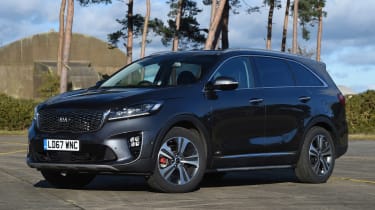
Kia Sorento Mk3: 2014-2020
The Mk3 Sorento came with a choice of five or seven seats, along with a strong 2.2-litre diesel engine. Buyers wanting some off road ability will probably look to the four-wheel drive versions, while there's also manual or automatic models to consider. Equipment levels are high across the range, with even entry cars including a DAB radio, Bluetooth, air-con, rear parking sensors, privacy glass and cruise control. Read our full Mk3 Kia Sorento buyer’s guide here…
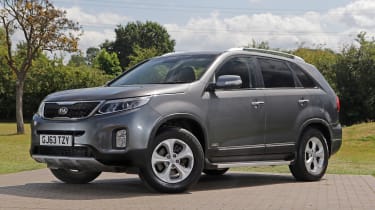
Kia Sorento Mk2: 2010-2014
As a capable seven-seat SUV with good towing capability, the Mk2 Sorento offered a reliable alternative to the agricultural Mitsubishi Shogun or Toyota Land Cruiser, while it undercut the significantly more expensive Land Rover Discovery on price. Both front- and four-wheel-drive examples are available, with petrol and diesel power featuring in the lineup. Read our full Mk3 Kia Sorento buyer’s guide here…
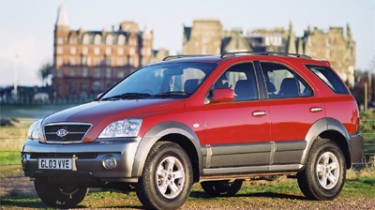
Kia Sorento Mk1: 2003-2010
The Mk1 Sorento was priced in a category below its size, which meant you got a lot of 4x4 for your money. It wasn't bad looking for the time and, tacky interior wooden trim aside, it was surprsingly well equipped too. Most examples came with a 2.5-litre diesel engine, although it didn't offer much pace.

